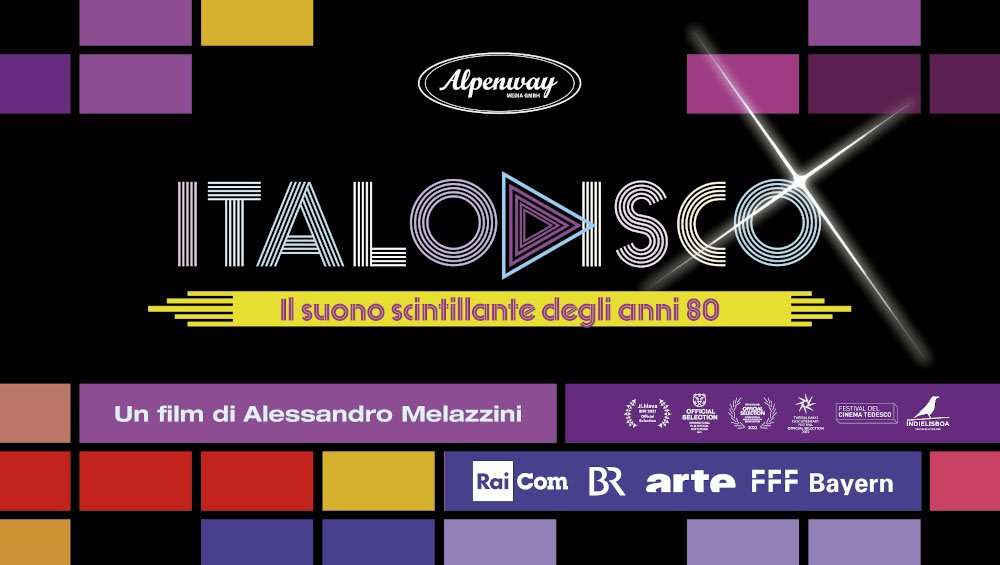Italo Disco, the sparkling sound of the 80s
31 Marzo 2022
di Paolo Morati

We were thrilled when we saw Italo Disco, il suono scintillante degli anni 80 (Italo Disco, the sparkling sound of the 80s), the documentary by Alessandro Melazzini dedicated to a musical genre that has travelled around the world and back. And this from the very first notes of Dolce Vita, the epic track by Ryan Paris, which fittingly launches a work that takes a historical approach to the subject and analyses its evolution with the testimony of protagonists and experts, both Italian and international. We talked about it with its author and director, who is very Italian but has been living in Germany for more than 20 years, which doesn’t seem to be a coincidence given that the take-off of the international popularity of Italo Disco began there…
Let’s start from the beginning of the documentary, when Sabrina Salerno states that the 80s were told in a very superficial way… Do you agree with this statement?
Sabrina is a stakeholder, so it is normal that she has experienced certain criticisms of the past badly, so much so that at the beginning she was a little reluctant to be interviewed. Once the nature of the project was understood, there were no problems. Having said that, Italo Disco’s productions have lent themselves easily to criticism, even considering their shiny and colourful aesthetic. In short, many will have wrinkled their noses and thought: under the dress nothing. The 80s came after the 60s and 70s, and this is not just a chronological fact. The former were a creative breeding ground for music, while the latter were characterised by a strong political commitment, especially in Italy. Many committed critics have therefore regarded the 1980s with the snootiness of older brothers and sisters towards younger ones: the years of disengagement, of reflux. The superficial years. With the distance of today, all this can be observed from a wider perspective. Time passes and allows us to analyse more thoroughly and with less prejudice whether and what was beneath that surface. This is precisely the approach I took in making the documentary.
So let’s start with the genesis of this project. How did it come about and what were its objectives? On what basis were the testimonies and the various pieces cited selected?
Over the past decade, I have devoted myself to a wide range of topics, from the social to the spiritual. This documentary came after I had already made a first work on the world of pop and in particular on the scandalous life of Ilona Staller, better known as Cicciolina. A work that was initially surrounded by prejudices (I co-produced it with the French/German channel ARTE, RAI refused) but which subsequently gave me much satisfaction. One day, I even received a complimentary message from Margarethe Von Trotta, who confessed to me that she had re-evaluated the character after seeing the documentary. When I finished that project, now available in Italy on Sky, I turned to a slightly different subject: the cultural heritage of the Cistercian monks. It is a subject that has given me a lot, in terms of reflection and human knowledge, to me who have been interested in Zen Buddhism for years. In particular, I have remained particularly attached to the Abbot of the Monastery of Chiaravalle Milanese. Having completed the work on the monks, unfortunately not yet available in Italy, and producing in parallel various TV documentaries by other directors with my company Alpenway (alpenway.com/italodisco) and assisted by my valuable colleague Marisa Scherini, I began to intensify my commitment to Italo Disco, having managed to convince ARTE and Rai Com. I then began to study and document myself, drawing on various sources, many of which were available via the Internet thanks to the incredible passion of real fans. I remember reading with interest the biography of Claudio Cecchetto and the volume The History of Italo Disco by Francesco Cataldo Varrina, as well as international essays. It was not a short process of study and information, aimed at structuring the whole thing not as a series of interviews but as the story of an artistic, sociological and economic journey of a phenomenon that in Italy was little considered at the time. It was a world in which singers were an important part, but producers were perhaps more important, not forgetting DJs and composers. Among these, I immediately had the desire to interview Pierluigi Giombini, to whom we owe great hits such as Dolce Vita, Masterpiece, I like Chopin. In short, I wanted to show the multifaceted nature of a phenomenon by following a certain philological path. Obviously, since I had to keep to the television schedule (the documentary lasts 53 minutes for TV and about ten minutes longer for the festival version, editor’s note), I couldn’t include everything I wanted to. However, I selected not only famous names such as the La Bionda brothers or Sabrina, or the beginning and end of Italo Disco, but also productions that are better known abroad than in Italy, such as Roberto Zanetti, aka Savage (recently interviewed by Indiscreto, ed). I won’t hide the fact that I have also received some no’s or no responses. This was the case with Daft Punk, Giorgio Moroder and Cecchetto himself. On the other hand, I have involved lesser-known personalities in Italy, such as Linda Jo Rizzo, the voice and then also the face of the Flirts, to mention an American contribution to Italo Disco, as well as recounting how, at the time, there were real projects based on image with real singers behind the scenes. I couldn’t help but interview a few fans, and I chose Flemming Dalum from Denmark, who has a huge vinyl collection and now remixes past hits. Because of the pandemic and, above all, big budget restrictions, I could not go to Mexico where there is a large Italo Disco fan base or film a themed festival that was to be held in Bergamo in 2020. I tried in the narrative to touch on the origins to get to the reasons why the phenomenon is dying out. As La Bionda explain, Italo Disco in its final phase lost its lustre due to the uncontrolled multiplication of bad productions. When the majors caught wind of the deal, after snubbing the genre for years, they incorporated it, diluting the positive energy that had produced great successes generated by an incredible mix of mainstream and underground.
The story begins in the late 1970s, with the first tracks by the La Bionda brothers and the earlier contaminations of Giorgio Moroder’s Munich Disco. So who are the fathers of Italo Disco?
You can’t choose a name, but the first synthesisers certainly set the tone. La Bionda played a key role here, but we should not forget important figures such as Freddy Naggiar of Baby Records or Claudio Simonetti and Mauro Malavasi, who are mentioned in the documentary by DJ and wholesaler Claudio Casalini. I saw a link between Italian disco and Italo disco in the group Easy Going, important also for their impact on the so-called ‘gay culture’, as sociologist Ivo Stefano Germano explains in the documentary. Then there are a whole series of tracks that for reasons of time and rights I wasn’t able to include, but which I like a lot and find really innovative. I’m thinking of Mr. Flagio’s Take a Chance, Cellophane’s Gimme Love, not to mention all the talk about the Creatures, the group that played at Altromondo Studios in Rimini and had wonderful covers: I couldn’t get the rights to show them in the documentary, what a shame.
The approach followed was not only an analysis from a historical and musical point of view, but also a social one. In particular, it talks about the role of the DJ. It emerges, for example, that in Italy they become ‘artists’. What does this mean, and how has it evolved over time?
Thanks to Italo Disco and megadiscos, the figure of the DJ has gone from the loser who plays the records in the club to the priest of the night, who officiates the ‘pop mass’ in front of his faithful. The figure of the superstar DJ of today, very present in Northern Europe, was basically born thanks to the Italians. This is what German-Italian music producer and label creator Mathias Modica talks about in the documentary. It all starts in the mid-1970s on the Romagna Riviera, even before the opening of the famous Studio 54 in New York. Think of the Baia Imperiale in Gabicce Mare, the first Baia degli Angeli, founded in 1975, where the console was located in a lift that went up and down the various floors of that architecturally futuristic disco. And it was no coincidence that everything started in the Emilia-Romagna area, not only because of the presence of entrepreneurs capable of investing in the entertainment industry but also because of the presence of merry-go-round factories, that is, the great mechanical capacity introduced into the structures of the large discotheques. At the same time, it became necessary for the ritual of the night to produce a lot of music, but also to encourage people to dance. So the DJ was no longer someone who played records, but someone who actively participated in the entertainment spectacle. This is what the famous DJ Daniele Baldelli talks about, who did not really have a positive opinion of Italo Disco at the time, an opinion he has since revised over the years.
Are there other phenomena in the world comparable to Italo Disco, born from below and then spreading worldwide?
It is well known that in Italy we have difficulty in appreciating what we produce, and indeed we are ready to criticise it if it is successful abroad. Having said that, the mechanism that led to the birth of Italo Disco, which was initially produced in cellars, I have found in other genres that I particularly appreciate. Like Ska and Rocksteady, genres to which I dedicated the first Italian website on the subject, skabadip.com, in 1999. In Jamaica in the early sixties, some entrepreneurs began to use trucks as travelling discos, equipped with large speakers that played music. These improvised discos were so successful that they pushed local musicians to expand the offer, until then confined to hits imported from the United States, with new and local sounds, leading to the birth of Ska. Similarly, in Italy, commercial necessity was combined with the creativity favoured by synthesisers and the possibility of experimenting with new sounds. To this was added tourism from other European countries, which led to a mix of cultures and people and a response to the demand for a union of many worlds.
Who was Severo Lombardoni, founder of Discomagic Records, and why is he such a central figure in this journey?
Not the first producer to devote himself to Italo Disco, but a decisive entrepreneur for several reasons. His Discomagic was one of the biggest and most successful labels in the industry, so he was able to attract more composers and producers. This was the case with Pierluigi Giambini, for example, who explains how he approached him with Dolce Vita, and got a less than enthusiastic reaction from Lombardoni, who was nevertheless convinced thanks to the comment of one of his assistants who had apparently heard the track by chance. Incidentally, when Savage saw the documentary, he told me that the same thing had happened to him. It was probably a commercial strategy on Lombardoni’s part, to diminish the value of a song that he had realised had the potential to be a worldwide hit, in order to lower the purchase price. In fact, he knew how to do it, proof of which is that his Discomagic was a well-known name abroad.
In fact, the documentary also shows the role of the German discography in the success of Italo Disco in the world, thanks to the contact with Lombardoni himself…
Lombardoni used to attend international trade fairs and it was there that the German discographer Bernhard Mikulski noticed a new musical genre coming out of Italy. So he decided to go to Milan with his wife, whom I interviewed, to look for Discomagic. After an adventurous journey (there were no navigators and the couple didn’t speak a single word of Italian), they managed to pick up some crates of records and took them to Germany. That was a time when music still had a concrete physical form, so the German distribution system proved fundamental to the spread of a genre that Mikulski decided, as his wife says, to call Italo Disco. Basically, he realised that the trick was to bring to Germany the music that tourists had heard in Italy and that reminded them of the good holiday season. And so Italo Disco in Italian discos in summer and Italo Disco in discos on the other side of the Alps in winter. In short, Italo Disco for all seasons. Mikulski fed an international market and, with his covers, he also fed an aesthetic. Without him, perhaps Italo Disco would not have had the same international impact that it did. And it would certainly have had a different name.
At a certain point, it is explained that Italo Disco is a mixture of technique and sound derived from electronics and the new instruments available and the romantic vein of Italian music. Hence its success. At the same time, Daniele Baldelli talks about the various sub-genres that make up Italo Disco. Which is the best in this sense?
Certainly Italo Disco had at least two souls, well represented by the Milanese school (electronic soul) and the Roman school (melodic soul). Initially, it was the former that emerged, while it is to the latter that we owe the more ‘romantic’ tracks, those of Gazebo to be precise, with music by Giombini. I love many types of music, from Ska, Rocksteady and Reggae to Dub and electronic, but I only really got into Italo Disco when I worked on this project. I love almost all the songs I chose for the soundtrack: I had to negotiate for a long time to find and get the rights.
The role of songs like Vamos a la playa and Righeira’s No tengo dinero is particularly important. With the video of the latter highlighted as fundamental in its futurist message by sociologist Ivo Stefano Germano. At the time, the cultural impact of these songs and their aesthetics had not been taken into consideration….
It seems to me that you also share the opinion of many: Ivo is the real hero of the film! A scholar who goes against so much arrogance of high culture towards pop culture. It seems unbelievable to talk about futurism today with respect to Righeira, with Johnson Righeira who, among other things, declares himself a futurist, but if we look carefully at the video for No Tengo Dinero, produced by La Bionda, we discover a whole series of sensational symbols. I find this postmodern mixture of high and low culture very interesting, if we want to use these two categories, knowing that Ivo would rightly slap our hands. I won’t hide the amusement of having been able to quote Herbert Von Karajan in a documentary on Italo Disco. Why? I leave it to the viewers of the film to discover.





Commenti Recenti